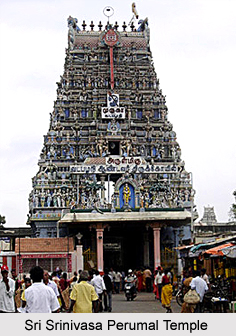 Urapakkam is located in Kanchipuram district in Chennai in Tamil Nadu. It is a census town situated on the National Highway 45. It is a part of `Golden Quadrilateral` National Highway Project. The town is a rapidly developing locality among the southern suburbs of Chennai. The town is located almost 8 kms from Tambaram and 21 kms from Chengalpattu. Urapakkam belongs to the Chengalpet Taluk and is situated between Vandalur and Guduvancheri. The town is divided into east and west by a railway line running through it. The town is enclosed on its eastern side by Karanai-Puducheri and Iyenchery villages, on its western side by Madambakkam and Adhanur villages, on its northern side by Vandalur and on its southern side by Guduvancheri.
Urapakkam is located in Kanchipuram district in Chennai in Tamil Nadu. It is a census town situated on the National Highway 45. It is a part of `Golden Quadrilateral` National Highway Project. The town is a rapidly developing locality among the southern suburbs of Chennai. The town is located almost 8 kms from Tambaram and 21 kms from Chengalpattu. Urapakkam belongs to the Chengalpet Taluk and is situated between Vandalur and Guduvancheri. The town is divided into east and west by a railway line running through it. The town is enclosed on its eastern side by Karanai-Puducheri and Iyenchery villages, on its western side by Madambakkam and Adhanur villages, on its northern side by Vandalur and on its southern side by Guduvancheri.
Urapakkam Panchayat is a part of the Kattankulathur Panchayat Union. The village of Nandivaram buffers Urapakkam with Guduvancheri and the village Otteri buffers Urapakkam with Vandalur. Apart from these villages there are many other important areas in Urapakkam include Priya Nagar, Revathipuram, Arul Nagar and M.G. Nagar in Urapakkam west, Yamunai Nagar, Sri Sathya Sai Nagar in Urapakkam east and Kubera Nagar. According to the census report of 2001 the population of Urapakkam was almost
13,445.
Pilgrimages Places of Urapakkam
Urapakkam located in Chennai is a famous pilgrimage centre visited by many devotees. Some of the important temples located in the town are Sri Sakthi Vinayagar temple, Manneswarar Temple, Karaneeswarar Temple, Kolatchi Amman Temple, Sri Muthu Maari Amman Temple, Shirdi Sai Baba Temple, Kailasanathar Temple, Sri Srinivasa Perumal Temple, Sri Selva Vinayagar Temple, Priya Nagar, Sri Selva Vinayagar Temple, Priya Nagar, Sri Vishnu Temple and others.
Educational Institutes in Urapakkam
Urapakkam has established many schools and colleges to cater to the needs of education of the town. Some of the important schools and colleges located here are Shri Sankara Vidyalaya Matriculation School, Vidya Mandir, Saraswathi Vidyalaya Matriculation School, Neelan Matriculation School, St. Johns Matriculations School, Deva Annai Matriculation Higher Secondary School, Eva Stalin Business School, B. S. Abdur Rahman Institute of Science and Technology, Sri Ramanujar Engineering College, Valliammai Engineering College and SRM University.
Urapakkam is well connected with all modes of transport. It is located on GST Road and is connected to all the major locations like Airport, Tambaram, Mahindra City, OMR, Oragadam, Sriperumbudur, etc. Urapakkam also has the advantage of being connected via Suburban railway network. There are many busses available for the town. The nearest railway station is located in Urapakkam. With the expansion of the southern limit of Chennai Metropolitan Area the town is now regarded as the Gateway of South Chennai on GST Road. The Oragadam-Sriperumbudur Road, Vandalur-Kelambakkam Road and the Outer Ring Road I s located close to the town. Urapakkam also has a railway station and two bus stops.



















